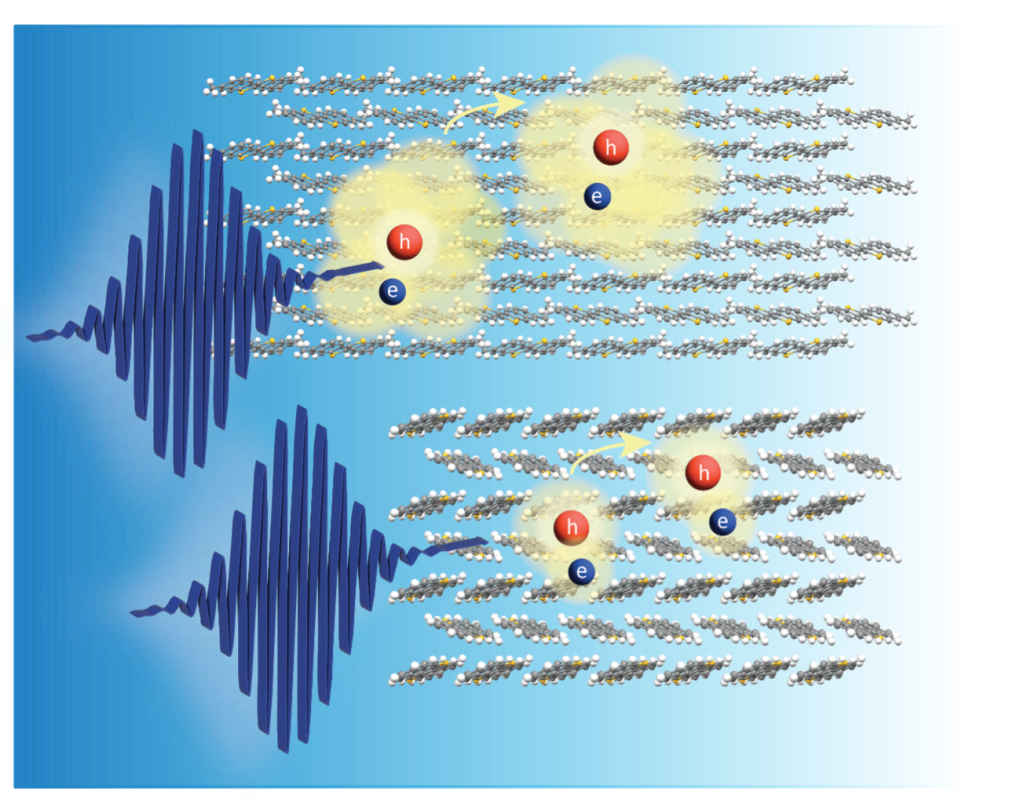Transiently delocalized states enhance hole mobility in organic molecular semiconductors

Increasing electrical conductivity with insulating groups.
Organic semiconducting crystals are carbon-based materials in which molecules are held together by weak intermolecular forces. These materials can conduct electrical current owing to the presence of relatively unbound and, in some cases, partially delocalized electrons across several molecular units. These microscopic properties lead to both mechanical flexibility and electro-optic responses promising for flexible electronic applications and industries such as electronics, displays, renewable energy, sensing, and healthcare. There has been significant progress in the development of organic semiconducting devices, particularly regarding reaching high electrical mobilities. Still, these values are approximately one order of magnitude lower than their inorganic counterparts. The primary sources limiting charge mobilities in molecular systems are molecular motions triggered by temperature, which negatively impact the motion of the electrons. Understanding how temperature and electron-nuclear interactions affect the charge transport mechanism is essential for designing more efficient organic semiconductors.
A consortium of researchers including TYC researchers Jan Elsner and Jochen Blumberger and former TYC member Samuele Giannini has made an important step towards comprehensively understanding the factors affecting charge mobility in organic materials. By combining terahertz ultrafast spectroscopy with quantum dynamical simulations, the researchers investigated the strikingly different dependence of electrical mobility as a function of temperature in two semiconducting crystals composed of chemically similar molecules: DNTT, and its alkylated derivative, C8-DNTT-C8. Although both systems show an increase in mobility with decreasing temperature, the rate of this increment is much larger in C8-DNTT-C8 compared to DNTT. This is remarkable, because the C8 groups are excellent electrical insulators.
The mobility increase upon lowering the temperature is often considered a hallmark of delocalized band transport. Yet, frequency-resolved measurements reveal a deviation from a pure free carrier response and characteristic features of only partially delocalized carriers in these systems. Our modeling indicates that the charge delocalization – directly linked to charge mobility – is larger in C8-DNTT-C8 than in DNTT. Furthermore, in C8-DNTT-C8 the delocalization increases rapidly with decreasing temperature, owing to reduced thermal disorder. The theoretical analysis reveals the rules governing this behavior, and indicate the possibility to reach extremely high mobilities by appropriately engineering the material properties.
Authors: Samuele Giannini, Lucia Di Virgilio, Marco Bardini, Julian Hausch, Jaco J. Geuchies, Wenhao Zheng, Martina Volpi, Jan Elsner, Katharina Broch, Yves H. Geerts Frank Schreiber, Guillaume Schweicher, Hai I. Wang, Jochen Blumberger, Mischa Bonn and David Beljonne
Nat. Mater. (2023). https://doi.org/10.1038/s41563-023-01664-4
